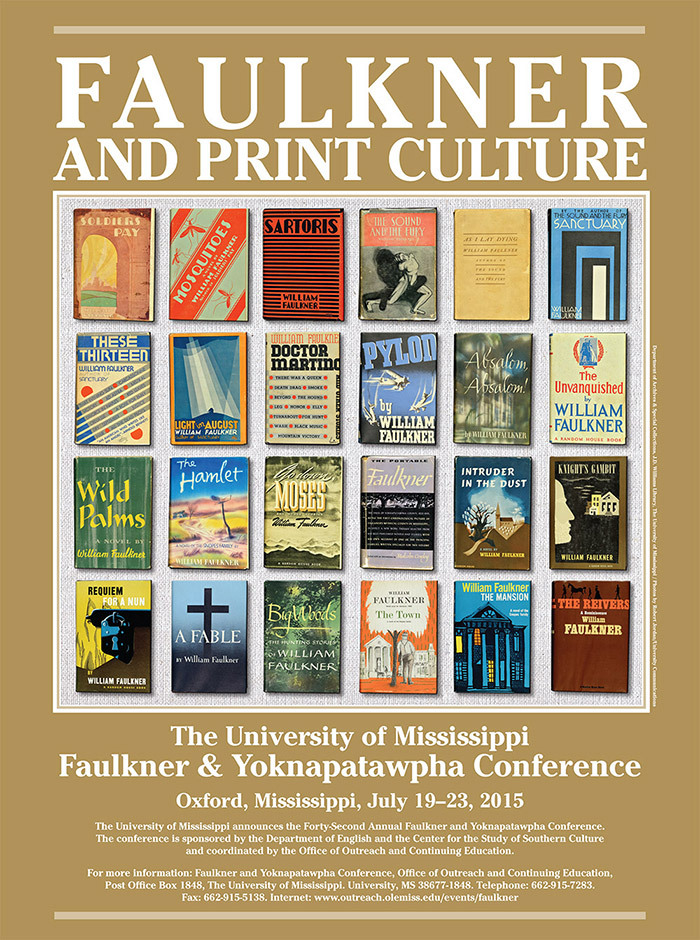
Panel. Faulkner and the Popular Magazine
Location
Nutt Auditorium
Start Date
21-7-2015 11:00 AM
Description
- Programmed for Seduction: Faulkner's Fiction and Men's Magazines of the 1950s / Kristi Rowan Humphreys, Texas Tech University
This study analyzes the use of Faulkner’s fiction in men’s magazines of the 1950s, The Dude: The Magazine Devoted to Pleasure (1956) and The Gent: An Approach to Relaxation (1957). The characters and themes in Faulkner’s stories integrate with the seemingly disconnected adjacent content, thus working toward the magazines’ ultimate goals of seduction. This study contends that an analysis of these integrations—of Faulkner’s short stories and their neighboring content—within both 1957 issues of The Dude and The Gent, reveals the ways in which Faulkner’s fiction has been programmed for seduction. - Gearing Up For War: Faulkner's "Two Soldiers" and The Saturday Evening Post / Jennifer Nolan-Stinson
“Two Soldiers,” Faulkner’s story about a young boy’s reaction to his brother’s decision to enlist after Pearl Harbor, appeared as the lead item in the March 28, 1942 issue of The Saturday Evening Post during a period of editorial upheaval and increasingly war-oriented coverage. Looking beyond the text, the advertisements, articles, and even the poetry bombard the reader with evidence of and calls for service. In this context, “Two Soldiers” provides a rare and much-needed expression of Americans’ complex and conflicted feelings about having recently entered the war, which challenges scholarly oversimplifications of the story as unequivocally patriotic or mere pandering. - "The Most Horrific Tale": Faulkner, Sanctuary and The Shudder Pulps / Matthew R. Vaughn, Jefferson College
Although Sanctuary is usually considered an example of Faulkner’s “popular” work, its startling combination of pulp horror with modernist technique illustrates the aesthetic affinity between pulp and modernist writing. By reading Sanctuary alongside the pulp horror stories of John H. Knox, I demonstrate the ways in which both horror fiction and Faulkner’s novel combine sensationalism with a modernist subversion of heteronormativity. In Sanctuary and horror fiction, the pleasure of the sensational text is derived not through identification with the villain but through vicarious participation in the distress of the pulp damsel.
Relational Format
Conference proceeding
Recommended Citation
Humphreys, Kristi Rowan; Nolan-Stinson, Jennifer; and Vaughn, Matthew R., "Panel. Faulkner and the Popular Magazine" (2015). Faulkner and Yoknapatawpha Conference. 15.
https://egrove.olemiss.edu/fy/2015/schedule/15
COinS
Jul 21st, 11:00 AM
Panel. Faulkner and the Popular Magazine
Nutt Auditorium
- Programmed for Seduction: Faulkner's Fiction and Men's Magazines of the 1950s / Kristi Rowan Humphreys, Texas Tech University
This study analyzes the use of Faulkner’s fiction in men’s magazines of the 1950s, The Dude: The Magazine Devoted to Pleasure (1956) and The Gent: An Approach to Relaxation (1957). The characters and themes in Faulkner’s stories integrate with the seemingly disconnected adjacent content, thus working toward the magazines’ ultimate goals of seduction. This study contends that an analysis of these integrations—of Faulkner’s short stories and their neighboring content—within both 1957 issues of The Dude and The Gent, reveals the ways in which Faulkner’s fiction has been programmed for seduction. - Gearing Up For War: Faulkner's "Two Soldiers" and The Saturday Evening Post / Jennifer Nolan-Stinson
“Two Soldiers,” Faulkner’s story about a young boy’s reaction to his brother’s decision to enlist after Pearl Harbor, appeared as the lead item in the March 28, 1942 issue of The Saturday Evening Post during a period of editorial upheaval and increasingly war-oriented coverage. Looking beyond the text, the advertisements, articles, and even the poetry bombard the reader with evidence of and calls for service. In this context, “Two Soldiers” provides a rare and much-needed expression of Americans’ complex and conflicted feelings about having recently entered the war, which challenges scholarly oversimplifications of the story as unequivocally patriotic or mere pandering. - "The Most Horrific Tale": Faulkner, Sanctuary and The Shudder Pulps / Matthew R. Vaughn, Jefferson College
Although Sanctuary is usually considered an example of Faulkner’s “popular” work, its startling combination of pulp horror with modernist technique illustrates the aesthetic affinity between pulp and modernist writing. By reading Sanctuary alongside the pulp horror stories of John H. Knox, I demonstrate the ways in which both horror fiction and Faulkner’s novel combine sensationalism with a modernist subversion of heteronormativity. In Sanctuary and horror fiction, the pleasure of the sensational text is derived not through identification with the villain but through vicarious participation in the distress of the pulp damsel.

